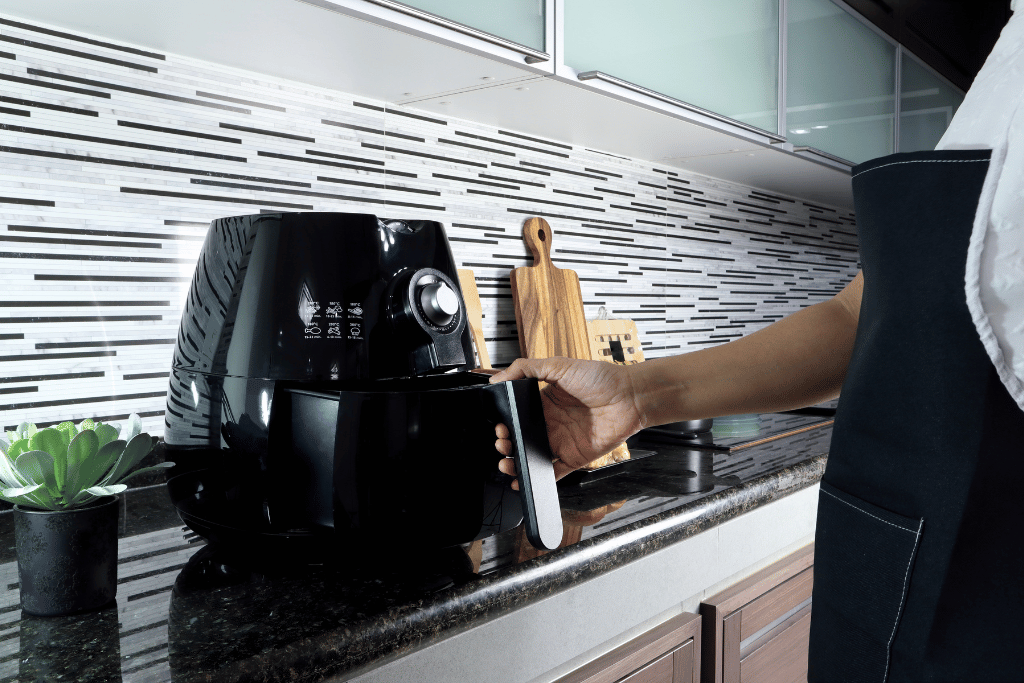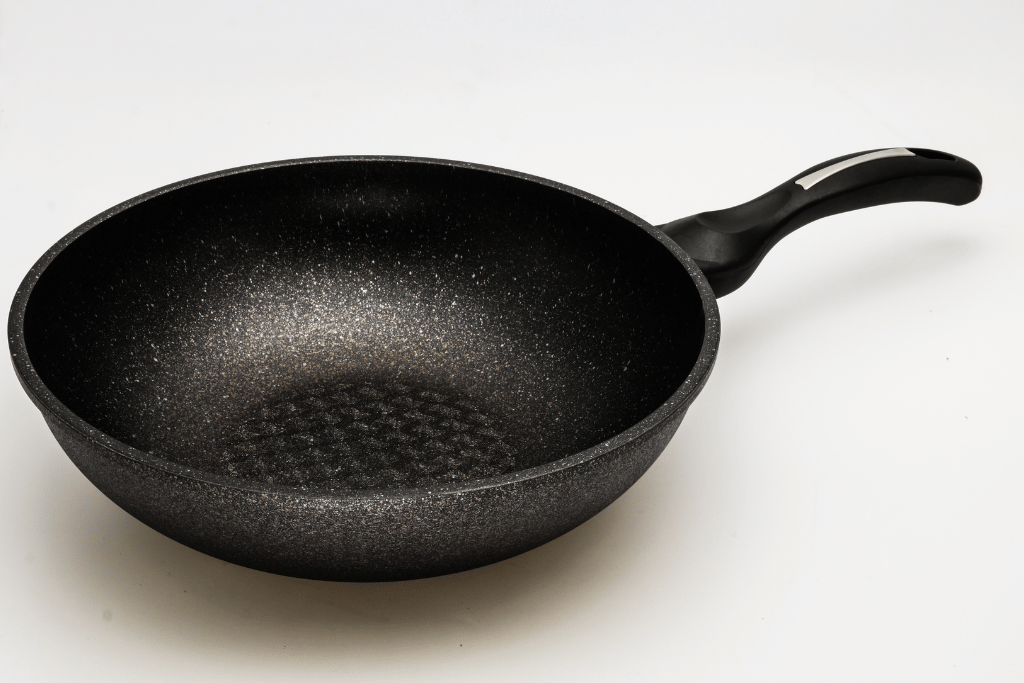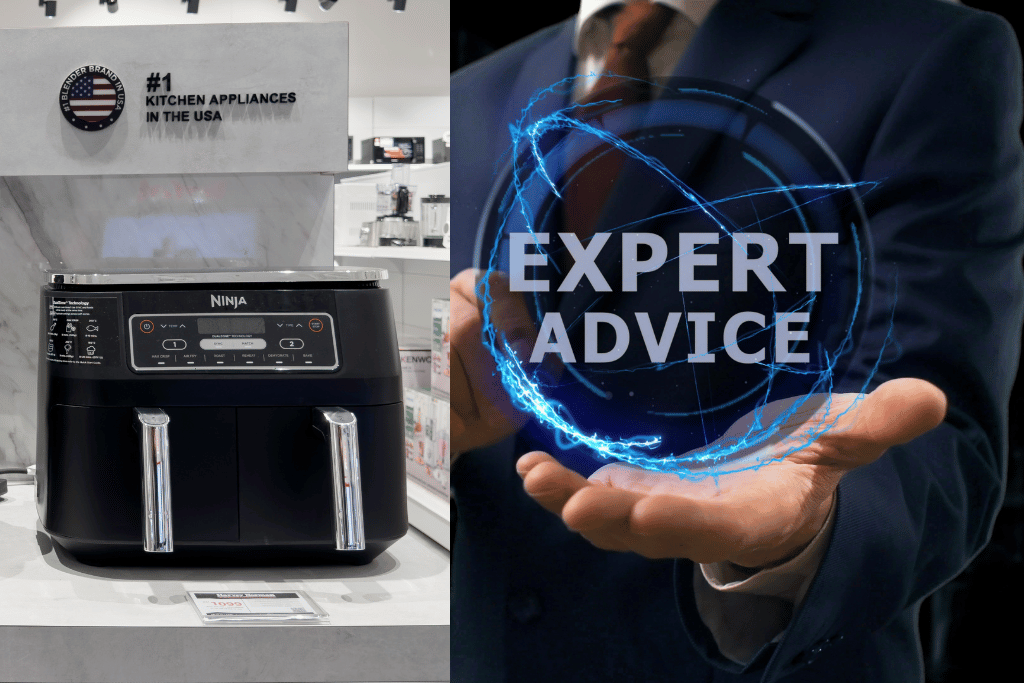
In the ever-evolving landscape of kitchen appliances, one standout gadget has taken culinary enthusiasts by storm: the air fryer. With its promise of healthier and crispier alternatives to traditionally fried foods, air fryers have become a staple in modern kitchens.
Among the myriad of options available, the Ninja brand stands out for its innovative designs and reliable performance. As we delve into the intriguing world of kitchen technology, a fundamental question arises: Is the Ninja Air Fryer made of Teflon?
In this article, we’re diving into the topic of whether Ninja Air Fryer made of Teflon and looking at different coatings. Let’s explore the kitchen tech world together!
What is Teflon?
Teflon, a remarkable creation of science, is a type of polytetrafluoroethylene (PTFE) that has revolutionized cooking and kitchenware. Developed by DuPont, Teflon boasts extraordinary non-stick properties, making it a staple in our culinary world. Its surface reduces the need for excessive cooking oils and ensures food slides effortlessly off the cookware.
Teflon’s heat resistance is a standout feature, enabling it to withstand high temperatures commonly encountered in cooking. Its chemical inertness means it remains unaffected by reactions with various ingredients, ensuring durability over time. The material’s low friction coefficient makes it useful in both cookware and industrial machinery, reducing wear and tear.
Understanding Air Fryer Construction

At its core, an air fryer is a compact yet versatile appliance that mimics the process of deep frying by circulating hot air around the food, resulting in a crispy exterior and tender interior. To comprehend the materials involved in crafting an air fryer, we must first dissect its components.
- Heating Element: The heart of the air fryer, the heating element generates the required heat that cooks the food. It’s typically composed of a metal coil that radiates heat when electricity passes through it.
- Fan: The fan inside the air fryer circulates the hot air generated by the heating element, ensuring even and efficient cooking. This airflow is crucial for achieving the desired crispy texture.
- Cooking Chamber: The cooking chamber is the enclosed space where the food is placed for cooking. This chamber is designed to contain and distribute the hot air effectively.
- Cooking Basket: The cooking basket or tray is where the food is placed for cooking. It allows the hot air to circulate around the food, ensuring that every part is evenly cooked.
Materials Used in Air Fryer Construction
Air fryers are crafted using a combination of materials that contribute to their functionality, durability, and safety. Here are some of the common materials used in air fryer construction:
- Plastic: Many air fryers incorporate plastic in their exteriors, which helps keep the appliance cool to the touch. However, the internal components that come into direct contact with heat are usually made from more heat-resistant materials.
- Stainless Steel: Stainless steel is often used in the construction of the air fryer’s exterior and cooking chamber due to its durability and heat resistance.
- Non-Stick Coatings: The cooking basket or tray is often coated with a non-stick material to prevent food from sticking and to facilitate easy cleaning. Teflon (PTFE) is a well-known non-stick coating, but other alternatives like ceramic coatings have gained popularity due to health concerns associated with Teflon at high temperatures.
Non-Stick Coating Explained

Central to the efficiency and user-friendliness of air fryers is the presence of non-stick coatings. These coatings are designed to prevent food from adhering to the cooking surface, making the cooking process more convenient and cleaning up a breeze.
Among the various non-stick coatings, one name stands out: Teflon, also known as polytetrafluoroethylene (PTFE). Teflon is renowned for its exceptional non-stick properties, making it a popular choice in a wide array of kitchen appliances.
Teflon offers several advantages:
- Easy Release: Teflon-coated surfaces ensure that food slides off effortlessly, minimizing the need for excessive oil or fats during cooking.
- Effortless Cleaning: The non-stick surface reduces food residue buildup, simplifying the cleaning process.
- Even Cooking: Teflon promotes even heat distribution, preventing hot spots and ensuring uniform cooking results.
- Durability: When used and maintained properly, Teflon coatings can withstand regular use without chipping or peeling.
However, the use of Teflon has also raised concerns due to its potential to release harmful fumes when heated to high temperatures, a phenomenon known as polymer fume fever.
These concerns have spurred the development of alternative non-stick coatings, such as ceramic coatings, which offer similar non-stick properties without the associated health risks.
Ninja Air Fryer Overview
The Ninja brand has emerged as a frontrunner in kitchen appliance innovation, and their air fryer models have garnered significant attention. Among these models, the Ninja Air Fryer has stood out for its promising features and culinary capabilities. Let’s delve into an overview of the Ninja Air Fryer:
Key Features:

(A) Rapid Air Circulation:
Like other air fryers, the Ninja Air Fryer employs rapid air circulation technology to cook food quickly and evenly, producing a crispy exterior.
- Versatility: Beyond air frying, this appliance often offers functions like roasting, baking, and reheating, making it a versatile addition to any kitchen.
- Pre-Programmed Settings: Many Ninja Air Fryer models come with pre-programmed cooking settings for different types of foods, streamlining the cooking process.
- Capacity: Ninja Air Fryers come in various sizes to accommodate different serving needs, making them suitable for both small and large households.
(B) Material Composition:
While the precise material composition of the Ninja Air Fryer’s cooking chamber and basket may vary by model, many Ninja Air Fryers feature non-stick coatings on their cooking surfaces. This raises the important question: Is Teflon the non-stick coating used in Ninja Air Fryers, or have they adopted safer alternatives like ceramic coatings?
As health-conscious consumers become increasingly vigilant about the materials used in kitchen appliances, understanding the non-stick coating used in the Ninja Air Fryer becomes paramount. The subsequent sections of this exploration will delve deeper into the specifications and materials used in the Ninja Air Fryer, shedding light on whether Teflon or other alternatives play a role in its construction.
Material Specifications
To uncover the truth about the non-stick coating used in the Ninja Air Fryer, we turn our attention to the product specifications provided by the manufacturer. By scrutinizing the official information, we can gain insights into the materials that constitute this sought-after kitchen appliance.
- Official Documentation: Ninja provides product manuals and documentation that often include details about the materials used in their appliances. These documents may specify whether Teflon or other non-stick coatings are employed in the Ninja Air Fryer’s construction.
- User Reviews and Experiences: In addition to official information, user reviews and experiences can offer valuable insights into the materials used in the Ninja Air Fryer. Consumers often share their observations about the non-stick coating’s performance, durability, and potential health concerns.
Health and Safety Concerns
As we continue our exploration, it’s important to address the health and safety concerns associated with non-stick coatings, particularly Teflon (PTFE).

- Teflon and Polymer Fume Fever: At high temperatures, Teflon coatings can emit potentially harmful fumes, causing a condition known as polymer fume fever. Symptoms include flu-like reactions, such as fever, chills, headache, and respiratory irritation. However, it’s worth noting that reaching the temperatures required to release these fumes is unlikely during normal air frying, as air fryers typically operate within a safe temperature range.
- Evolution of Non-Stick Coatings: In response to health concerns, non-stick coatings have evolved. Many modern non-stick coatings, including ceramic coatings, are designed to be safer at high temperatures. Ceramic coatings are generally considered more heat-resistant and pose fewer health risks compared to traditional Teflon coatings.
- User Precautions: While the likelihood of encountering health risks from Teflon fumes during air frying is low, it’s advisable to take precautions. Ensure proper ventilation in your kitchen by using your air fryer in a well-ventilated area. Additionally, avoid using non-stick utensils that can scratch the coating, as damaged coatings may pose potential health concerns.
- Ninja’s Commitment to Safety: Reputable brands like Ninja prioritize the safety and satisfaction of their customers. They continually work to improve their products, including the choice of materials used. If health and safety concerns have led to the adoption of alternative non-stick coatings, Ninja may address these issues in their newer models.
- Consumer Awareness: As consumers, it’s crucial to be aware of the materials used in the appliances we bring into our kitchens. By understanding the potential benefits and risks associated with non-stick coatings, we can make informed decisions that align with our health and safety priorities.
Alternatives to Teflon
As concerns about Teflon’s potential health risks have grown, manufacturers have sought safer alternatives to traditional non-stick coatings. Let’s explore some of the alternatives that have gained prominence in recent years:
Ceramic Coatings:

Ceramic non-stick coatings have become a popular choice due to their ability to withstand higher temperatures without emitting harmful fumes. These coatings are often made from inorganic minerals and are known for their durability and scratch resistance.
Enameled Coatings:
Enameled coatings, commonly found in cast iron cookware, provide a natural non-stick surface that is safe at high temperatures. These coatings are created by baking a layer of porcelain enamel onto the cooking surface.
Silicone-Based Coatings:
Silicone-based coatings offer a flexible and heat-resistant alternative to traditional non-stick coatings. While they may not provide the same level of non-stick performance, they can still be effective for certain cooking tasks.
Maintaining and Using Non-Stick Air Fryers
Proper maintenance and usage of non-stick air fryers are essential to ensuring their longevity and safety. Here are some guidelines for maintaining and using your non-stick air fryer effectively:
- Avoid Metal Utensils: Use utensils made of wood, silicone, or plastic to prevent scratching the non-stick coating. Metal utensils can damage the coating and compromise its non-stick properties.
- Handwashing Recommended: While some non-stick air fryer components are dishwasher-safe, handwashing is generally recommended. Use a soft sponge or cloth and mild detergent to clean the non-stick surfaces gently.
- Preheating: Preheating your air fryer for a few minutes before cooking can help ensure even heat distribution and optimal cooking results.
- Proper Ventilation: Ensure your kitchen is adequately ventilated while using the air fryer. This helps prevent the accumulation of any fumes that might be emitted during cooking.
- Oil Usage: While air fryers require less oil than traditional frying methods, adding a light layer of oil to the food can enhance the flavor and texture. This can also help prevent excessive sticking to the non-stick surface.
- Cooking Spray: When using cooking spray in your air fryer, opt for an oil spray specifically designed for air frying to avoid damaging the non-stick coating.
- Regular Inspection: Periodically inspect the non-stick coating for any signs of damage, such as peeling or chipping. If you notice damage, consider replacing the affected component to maintain safe and effective cooking.
- Cool Before Cleaning: Allow your air fryer to cool down before cleaning. Cleaning while the appliance is still hot can damage the non-stick coating and cause warping.
By following these guidelines, you can ensure that your non-stick air fryer remains in optimal condition, providing you with delicious and healthy meals for years to come. As we navigate the landscape of non-stick coatings and their alternatives, it’s crucial to prioritize both our culinary experiences and our health and safety concerns.
Expert Opinions and Recommendations

Seeking insights from culinary experts and kitchen appliance specialists can provide valuable perspectives on the use of non-stick coatings in air fryers. While experts may vary in their opinions, their insights can guide us in making informed decisions about our kitchen appliances.
Health and Safety: Experts often recommend choosing air fryers with non-stick coatings that are designed to be safe at high temperatures. Ceramic coatings are frequently mentioned as a preferable alternative to traditional Teflon coatings due to their improved safety profile.
Usage Recommendations: Experts advise users to follow manufacturer instructions for proper usage and maintenance of non-stick air fryers. Preheating the appliance, avoiding metal utensils, and using minimal oil are among the commonly recommended practices.
Ventilation: Ensuring proper ventilation in the kitchen is crucial when using any kitchen appliance, especially those with non-stick coatings. This helps mitigate the risks associated with fume release.
Product Selection: Experts suggest researching product specifications and reading user reviews before purchasing an air fryer. This allows consumers to make well-informed choices that align with their preferences and safety concerns.
Conclusion
And there you have it! The mystery of whether the Ninja Air Fryer is made of Teflon has been quite the adventure. We’ve peeked into the world of coatings and cooking magic.
Through our investigation, we’ve learned that the composition of the Ninja Air Fryer’s non-stick coating can vary between models, and it’s essential to consult official documentation and user experiences to ascertain the specific materials used.
Remember, Teflon brings non-stick marvels, but it can be a bit finicky at high heat. So, whether you stick with Teflon, go for cool ceramics, or try something new, your kitchen journey is all about what suits your cooking style best.
Frequently Asked Questions
-
What are the Common Locations for Teflon Coating in an Air Fryer?
Teflon is frequently utilized on the interior surfaces of an air fryer, primarily on components such as the cooking basket or tray, offering a non-stick coating that facilitates cooking and easy food release.
-
Do air fryers without Teflon coating exist?
Certainly, air fryers without Teflon coating are indeed available in the market, offering alternatives such as ceramic or other non-stick coatings, catering to individuals who prefer or have concerns regarding Teflon-coated surfaces for health or other reasons.
-
How can you find out if your air fryer contains Teflon?
You can determine if your air fryer contains Teflon by referring to the product’s user manual, checking specifications, reading online reviews, or contacting the manufacturer’s customer support for clarity on the type of non-stick coating used.
-
What happens if you eat Teflon coating?
Consuming Teflon coating from cookware or utensils in small amounts is usually safe, passing harmlessly through the digestive system. Ingesting larger pieces or particles that have chipped off might cause minor discomfort. However, it’s recommended to avoid eating non-food items, including Teflon, and consult a medical professional if you experience any concerns or adverse effects.